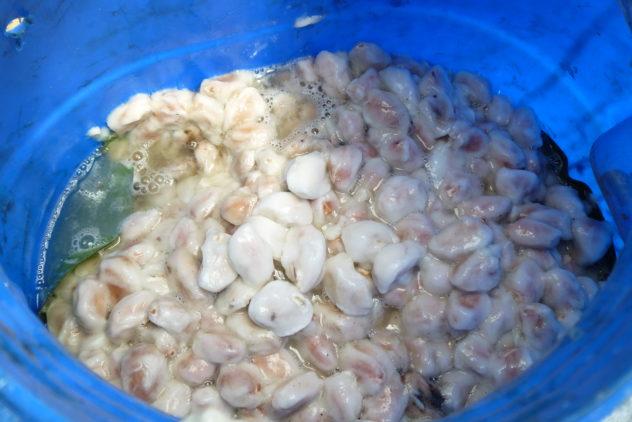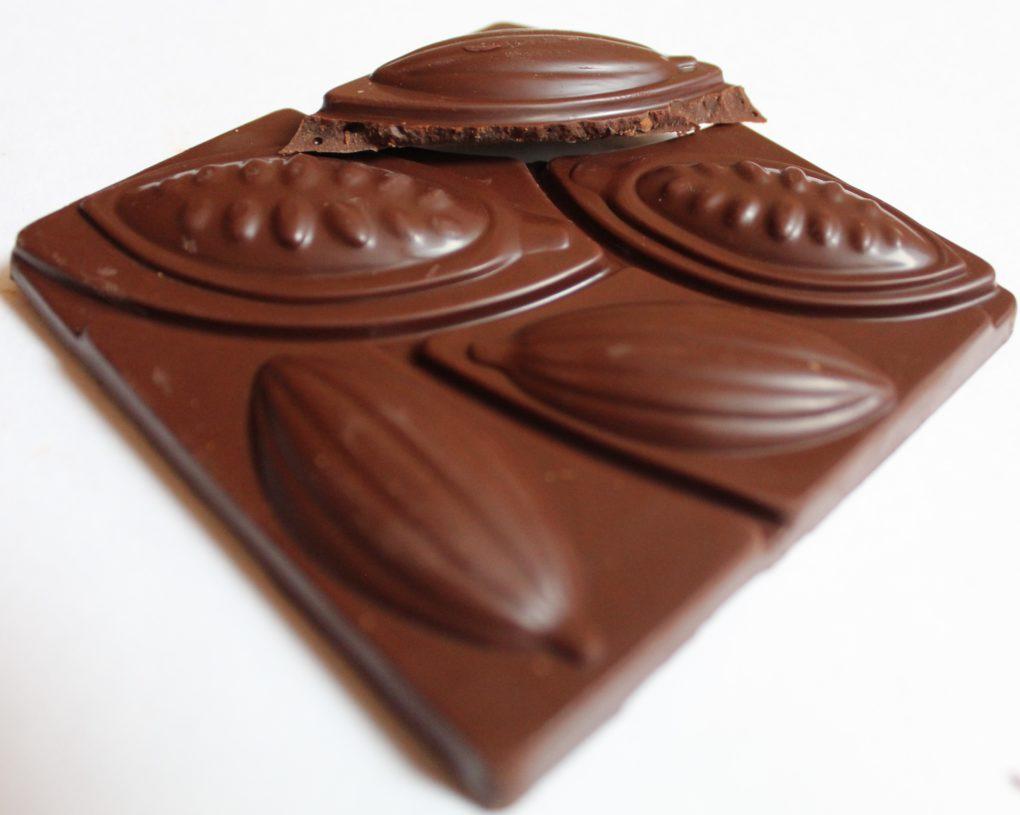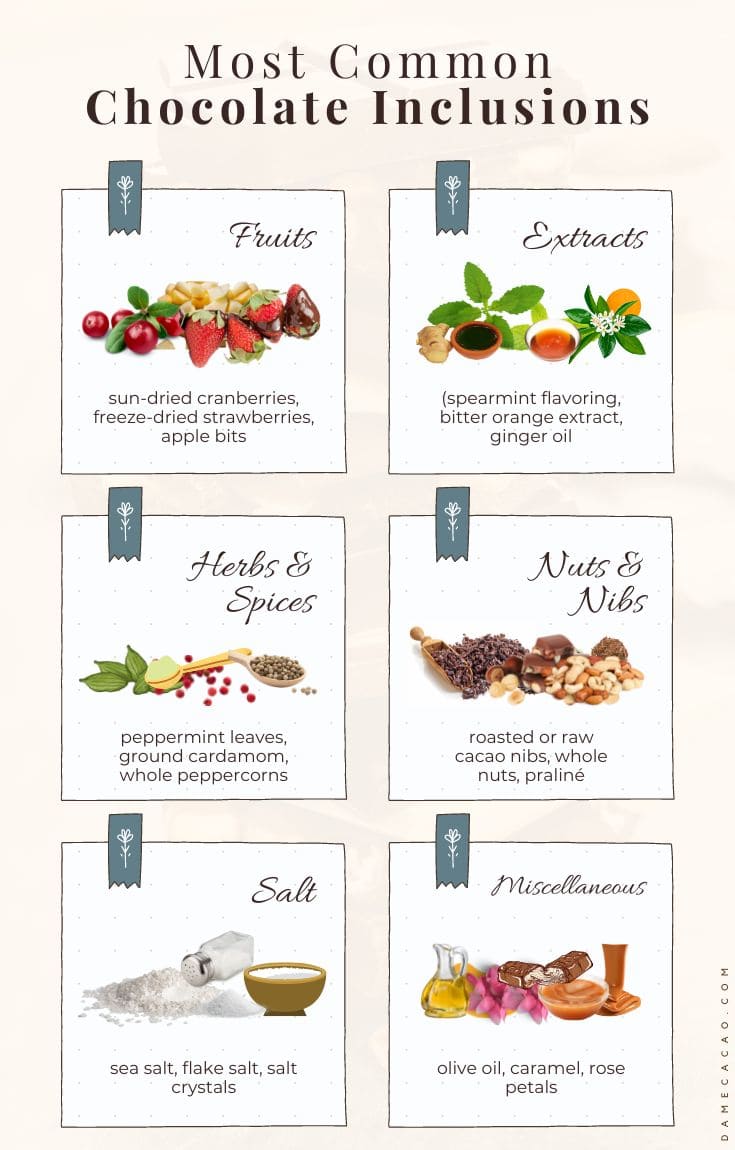Think of your favorite chocolate; just humor me. Is it a smooth milk chocolate? Or a dark bar with whole almonds on the back? Oh, or maybe a sweet white chocolate with bits of dried fruit? Whatever your fare of choice is, I'm sure you've run into some variants of those chocolate flavors.
The last two chocolates I mentioned actually feature inclusions, an industry term for any substance added to chocolate beyond the widely accepted ingredients (cacao, cocoa butter, sugar, milk powder, vanilla, and lecithin). In this article we'll dig into what constitutes an inclusion and what types of inclusions are out there, from coffee & cacao nibs to passion fruit pulp. Should you be using inclusions in your chocolate recipes?
This article was first published in 2015, and updated in 2023 to reflect the major growth and changes in the industry in the years since. To read about the evolution of nondairy milks in chocolate, click here.

Jump To
What are Inclusions in Chocolate?
Inclusions are extra ingredients added to chocolate, intended to improve the chocolate's overall impact, either flavor-wise or aesthetically.
Sometimes a chocolate maker or chocolatier adds inclusions for both flavor and visual appeal, much more common these days considering that we "eat with our eyes." One of the most common inclusions is vanilla. However, vanilla is so ubiquitous that it has become somewhat neutral territory in chocolate, and therefore is not generally considered a part of the "inclusion" category. In fact, to be considered as a contender in the Good Food Awards' Chocolate "Inclusion" category, a bar must include a flavoring ingredient other than vanilla!
General categories for inclusions, with examples:
- Fruits (sun-dried cranberries, freeze-dried strawberries, apple bits)
- Extracts (spearmint flavoring, bitter orange extract, ginger oil)
- Herbs & Spices (peppermint leaves, ground cardamom, whole peppercorns)
- Salt (sea salt, flake salt, salt crystals)
- Nuts & Nibs (roasted or raw cacao nibs, whole nuts, praliné)
- Miscellaneous (olive oil, caramel, rose petals)
You may think it's obvious how these ingredients affect the chocolate's final flavor— they make the chocolate taste like the inclusions, right? But this isn't always the case. Any chocolate reviewer can humbly impart this truth. Each ingredient, down to the added cocoa butter, affects the final experience for the consumer. The state of the ingredient, and when & where they're added during the chocolate making process also affect flavor & texture.
Jose Meza, Co-founder of Mindo Chocolate in Ecuador, has actually had a very unique approach to inclusions. When I interviewed him in Ecuador back in 2015, he was experimenting with adding inclusions directly to fermenting cacao. In one batch of beans I tried, he had added guava to the fermenting trough, imparting guava flavor to the beans without adding guava to the final product. Many believe that similar such projects may have been the inspiration behind Ruby Chocolate.

Inclusion Categories, In-Depth
Fruits
Bar example: Ginger Milk Chocolate by Alluvia
Fruits of any kind are almost always added at the end of processing, to the back of a freshly-tempered chocolate bar. Sometimes, however, they're added during cacao's fermentation (see above) or mixed in at the end in the form of a puree (similar to Zotter Chocolate's hand-scooped bars). They tend to add a less-strong flavor than extracts, and a pointedly chewy or crunchy texture. Sometimes a dash of salt or a sprinkle of nibs are added to emphasize the fruity sweetness, but in general, fruit clashes with other inclusions.
Extracts
Bar example: Theo Orange Dark Chocolate 70%
Always blended throughout the chocolate, extracts are added at the end of processing due to their fragility. Natural extracts such as ginger oil have the tendency to lose their flavor potency if heated, as would happen several times during the refining stage of the chocolate making process. Note that most bars will not include more than one flavor extract, due to their tendency to overwhelm the palate in high quantities.

Herbs & Spices
Bar example: Strawberry Basil by Raaka
Treated similarly by makers in terms of when and where they are added, herbs and spices are more popular with chocolatiers than with chocolate makers. Like extracts, herbs & spices such as peppermint leaves tend to lose their potency if exposed to too much heat, so they're always added at the end. Most of the time they're sprinkled delicately onto the back of the bar, just enough to stick onto the chocolate, but not so much that they're all you can taste. Only the most finely-ground herbs and spices are blended into the chocolate, and this is also done at the end of the process.
Salt
Bar example: Sea Salt 70% Dark by Theo Chocolate
It seems like a straight-forward addition to any well-meaning chocolate bar, but this is likely the most common chocolate inclusion, as well as the most flexible. Though chemically the same, each type of salt behaves differently in the presence of chocolate, depending on crystal size, source, when it was added, and paired inclusions. The most common form is large sea salt crystals— possibly because it sounds fancier— added to the back of a bar.
The sea, to be fair, is one of the most pure and aesthetically striking sources of salt available. If it is mixed into the bar, it can get so lost as to seem like a flavor note, and this is not an uncommon occurrence. That is why craft chocolate bars usually feature big crystals added to the back of a bar by hand. In this way, the taster can experience the pointed contrast between the sweet bar and the salt, each enhancing and complementing the other for a longer period.
Nuts & Nibs

Bar example: Malaysia 72% w/Nibs by Benn's
They come from similar places, both finding their origin hanging off of a branch, but they're vastly different in final effect. Nuts add a crunchiness (or a chewiness if they're old), and they tend to taste sweeter and earthier when raw. For example, macadamias add a sweet creaminess and nibs a brownie-like crunch, while peanuts lend a Reese's vibe. But cacao nibs are usually from the same origin as the cacao used to make the chocolate, so they have a reputation for emphasizing the sweetness in a bar by being not-sweet & often bitter.
These inclusions are pretty powerful flavors, so like extracts, they used to be added to lower-quality chocolate. Thankfully this is changing, as makers play around with the ingredients in their single-origin bars. But beware of imitators. Even craft chocolate with inclusions should still mention an origin for their beans, and not use any preservatives or strange-sounding chemicals. Nuts and/or nibs are usually paired with salt, if combined with any other inclusions.

Miscellaneous
Bar example: Fossa Chocolate Salted Egg Cereal Bar
This is the catch-all category, and as such it's hard to make generalizations about these inclusions. However, unlike more traditional inclusions, these are usually more expensive & harder-to-find or local ingredients. Fruits, nuts, spices; all of these can be found in varying quantities in all corners of the world, and it makes sense that makers might want to showcase them. Thus, bars which include an off-the-wall ingredient are usually a limited edition bar or a chocofied version of a local dish.
Some examples are rose petals on Ecuadorian bars, dulce de leche swirls in Argentinian chocolate, and olive oil & rosemary truffles in Italy, each of which adds textural depth as well as a contrast to the chocolate. Not all of these are craft chocolate, but they certainly could be. The quality of base chocolate used with such inclusions varies by maker, but if you like their single-origin bars, I'd take the leap and try one of their local specialties.

Why are Inclusions Significant to Experience?
At first glance, the point of inclusions seems to be familiarity, making the chocolate taste like something less rich, or more recognizable. But this ignores the fact that many makers add one flavor in order to emphasize another. In commercial ventures, often inclusions are meant to complement or cover the inherent flavors of cacao beans. They trick your palate by using both your nose & eyes to steer your brain in one direction or another.
By creating expectations through both sight and smell, added flavorings potentially do no more than help you realize what flavors were already there. Salt is usually used to make a bar taste sweeter, and fruit to bring out bright citrus or berry notes already present in the bar. Nibs are added to emphasize the flavor value of processing them into chocolate; no new ingredients are added, yet the same cacao can taste like a whole different food group.
My words are not the be-all, end-all on inclusions— there are exceptions to every rule. However this should serve as a guide to chocolate inclusions for all those curious about how their taste buds and nose are affecting their level of contentment (both with their new favorites and the old stand-bys).
If you're a chocolate maker, one way to appeal to a wider audience is to experiment with inclusions in bars. Adding inclusions to chocolate is a simple way to widen your customer base, especially when people see unique creations that they'd love to gift. Again, the eyes are the window to the soul AND the stomach. So why not add in some interesting inclusions the next time you're looking for a breath of fresh air?

What are your favorite chocolates with inclusions? Or do you stick to the pure bars, no questions asked?

















Folie
I was fascinated by knowing the journey of chocolate from bean to bar. This is really informative. Can't find any better article about chocolate inclusions.
Max
Aw thank you! I'm glad you found it informative. 🙂
Vivek Singhania
I m from India planning to start my bonbons and bean to bar business, I have 2 enquiries.
Firstly which company melangeur I can use for refining and conching to produce great quality bars, santha, Premier or any other company.
Secondly at which stage to all bean to bar craft chocolate makers add flavour like orange with cinnamon and ginger, strawberry with basils, raspberry with pistachio, etc. And in which form.
Do they add puree bfor tempering, or osa paste bfor tempering or that particular fruit oil etc. And in which form do they add herbs and spies.
Max
Ah, good luck with starting your business, Vivek! You can start with a small melangeur from any company, but Santha and Premiere both have good reputations.
As for the flavors, I recommend you re-read this part of the article: https://damecacao.com/what-are-chocolate-inclusions/#Herbs_Spices as it details when people usually add certain types of inclusions. You can add things in fresh or dried form, and infuse them or add them directly. Never add a paste or other liquid to your chocolate unless you want to ruin it. The exception to this is less than 0.5% of a flavoring liquid, and usually much less, like 0.1%.
Vivek Singhania
Thnx Max, is there any good link, website or book on details about different process/methods/techniques of infusions of local ingredients and at which stage of Chocolate Making.
Max
No problem! Funny enough, I can't think of any single book which covers all of that, though several books cover many of the finer points of infusing fats with flavors & measuring how much of any one inclusion to use. I'd recommend checking out this page on my site first, to see if any of these books or articles are helpful: https://damecacao.com/for-chocolate-makers/
Pranav Kyadar
Hi,
This is Pranav from India, an aspiring chocolate maker. Loved your blog on inclusion. I am trying to make a 55% milk chocolate infused with tea. How and when should I add tea to the melanger? I have read about infusing cocoa butter with tea and then adding it to the melanger. Should I try that or is their a different approach?
Max
Hi, Pranav! I'm glad you're enjoying the site. I've found that bars made with tea powder added directly tend to taste too bitter and astringent, and I really prefer bars made with infused cocoa butter. You should read some articles on infusing cocoa butter to understand it better, but basically you keep the tea leaves & cocoa butter warmed to low 40s/50s Celsius for a long period of time to infuse the tea flavor into the cocoa butter. Some makers also directly infuse the chocolate (with the same idea of infusing the flavor into the fat) before tempering. Fat carries the flavor, after all! You can try both methods and see which you prefer, but for a milk chocolate it may be easier to try infusing cocoa butter first. Good luck with your experiments!
Pranav Kyadar
Thank you for these amazing insights, I would surely work on it.
Max
No problem, Pranav!